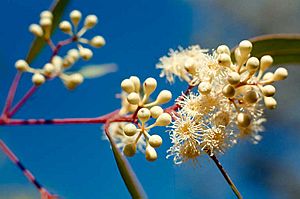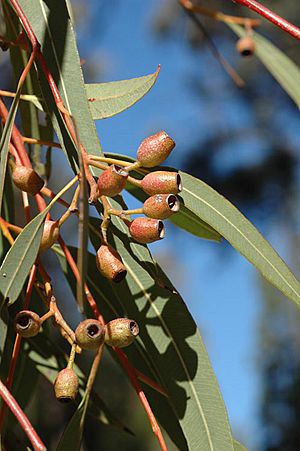Brown bloodwood facts for kids
Quick facts for kids Brown bloodwood |
|
|---|---|
 |
|
| Corymbia trachyphloia near the Blackdown Tableland | |
| Scientific classification | |
| Genus: |
Corymbia
|
| Species: |
trachyphloia
|
The Brown Bloodwood (scientific name: Corymbia trachyphloia) is a special type of tree. It is a small to medium-sized tree. You can only find it in eastern Australia. This tree has rough, patterned bark on its trunk. Its larger branches often have this bark too. It has long, narrow adult leaves. Its flower buds grow in groups of seven. The flowers are white, and its fruit looks like an urn.
Contents
What Does the Brown Bloodwood Look Like?
The brown bloodwood tree usually grows up to 15 meters tall. That's about as tall as a four-story building! It has rough, brown and greyish bark. This bark covers its trunk and often its bigger branches.
Leaves and Flowers
Young brown bloodwood trees have shiny green leaves. These leaves are paler on the underside. They are shaped like a spear, about 5 to 12 centimeters long. Adult leaves are usually a glossy dark green. They are also paler underneath. These leaves are narrow and spear-shaped. They can be 6.5 to 14 centimeters long.
The tree's flower buds grow in groups of seven. They are shaped like a pear. Each bud is about 4 to 5 millimeters long. The brown bloodwood flowers are white. They bloom from December to June. After flowering, the tree produces fruit. This fruit is thin-walled and shaped like an urn. It is about 6 to 10 millimeters long.
Where Does the Brown Bloodwood Grow?
You can find the brown bloodwood growing in sandy soils. It often grows on flat areas or on sandstone rocks. In New South Wales, it grows near the Goulburn River. Further north in Queensland, it grows in places like the Blackdown Tableland. It also grows in the Carnarvon Range and the Atherton Tableland.
How Was the Brown Bloodwood Named?
The brown bloodwood was first officially described in 1859. A scientist named Ferdinand von Mueller gave it the name Eucalyptus trachyphloia. He wrote about it in a science journal. He had collected samples of the tree near the Burnett River. Later, in 1995, two other botanists, Ken Hill and Lawrie Johnson, changed its name. They moved it to the Corymbia group of trees. So, its scientific name became Corymbia trachyphloia.



